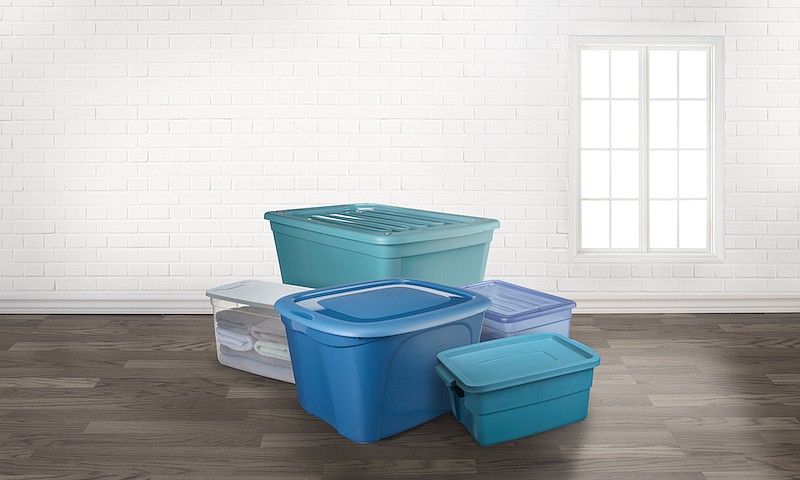Readers who are troubled with what in the world to do with summer "stuff" storage should appreciate today's column. (These ideas have worked very well indeed for Hubby and me since our move; however, you don't need to relocate in order to utilize the tips.)
Beach towels, picnic blankets, outdoor linens, and tableware are best stored in jumbo plastic tubs wherever space is available. (I must admit my family keeps beach towels in our linen closet year-round as we use them throughout the year for various reasons.)
Garden tools and pots can be stored in an outdoor storage bench or a two-door cabinet with shelves. To find the items easier come spring, group similar ones together. Another idea is to utilize tote bags to load with hand tools; park the tote on a garage shelf or in an outdoor shed. Thoroughly rinse empty flower pots. Stack them in tiers and layer between each with newspapers to prevent cracks and scratches. Those you don't wish to keep, ditch them at the next trash pickup date.
With respect to other summer yard essentials, such as hoses, sprinklers, and so forth, use bungee cords stretched between the garage walls' studs for easy storage.
Sandals and flip flops store best and together inside breathable canvas or clear plastic under-the-bed storage bins (which I use). Be sure to wash and dry the shoes before stowing them. (See shoe section at conclusion.)
String or solar lights are stored best in two ways: either in shallow containers to prevent overload breakage or around cardboard so tangling doesn't occur.
Summer clothes can be stored using a variety a variety of methods. Naturally, the best choice is in a closet if you have the room. Many of us, however, must plan other possibilities, such as a covered garment rack. Stow the rack in a dry area after cleaning the clothes (even if they appear to be spot-free). However, always discard the plastic cleaner's bags before storage of any kind as they can trap humidity or make it hard to lose any residual odor from the chemicals. Storing clothes in bags can also allow stains to oxidize and make the clothes harder to clean in the future.
Another quick idea is to remove folded clothing from drawers, such as shorts and tees, and switch them over to covered plastic bins that slide under the bed. Try rolling your clothing rather than folding to prevent hard creases from forming and do label each box so you can pull out the correct container should you need a piece. A really "refreshing" idea is to place a dryer sheet inside whichever container you use that will keep clothes smelling fresh.
If not a fan of plastic, take a drawer from a chest or a wooden box and attach casters to slide under the bed.
Use luggage for off-season storage but be sure to label each bag with what's inside. (I'm a big fan of this method in our new home; we hold several suitcases but possess little closet space to spare.)
Extra-large Ziploc bags (about $2 each at home centers and online) are great for storing camping gear, patio cushions, as well as my sister's solution - to store those out-of-season clothes. A wily trick for getting all the air out of the bag before you seal it is the exact same way in which I freeze fresh peas and corn during the summer growing season. Place your items inside the bag(s) and push out all the air you can. Then seal the bag but leave an opening only to fit a drinking straw; pop the straw in the itty-bitty gap and suck out the remaining air, then finish sealing the bag.
So, what's the best way to store shoes, boots, sneakers, heels, and sandals? My husband refers to me as "Imelda" (as in Marcos for those of us of a certain age). While I do admit to a passion for footwear, it's difficult to store out-of-season shoes when we ladies or gents have more than is really necessary. Before you start implementing any new shoe storage solutions, organize them into groups. First, divide your shoes into three categories: the shoes you wear all the time; the shoes you wear less frequently; and the ones you rarely put on your footsies (think stilettos or snow boots).
Now it's time to compartmentalize the remaining everyday shoes even further. Similar styles should stick together, such as shoes you wear to work in one group, those to wear out to dinner might be in another group, and shoes suited for doing a lot of walking could be in a third group. Yearly changing out my summer shoes for fall and winter and viceversa, is a tried-and-true method for both major clothing/shoe seasons. However, I must admit, this year was definitely a challenge. Normally, my rarely worn pairs go on a top closet shelf, but much less closet space now means adjustments must be implemented.
My "dressy" shoes (that I don't often wear any longer but can't bear to get rid of!) and boots (May we please have some cold weather?) had to go somewhere as summer shoes in the past have filled up an entire top shelf and the former – as well as purses - staycationed on another high one. A dearth of shelves, unfortunately, came with the house, so my bags now reside inside boxes that sit on top of an old chest in the closet.
The plan was to have a clean chest top on which to place some of our overabundance of beloved family photos, but "The best laid plans of mice and men"
Contact Ellen Phillips at consumerwtach@timesfreepress.com.

